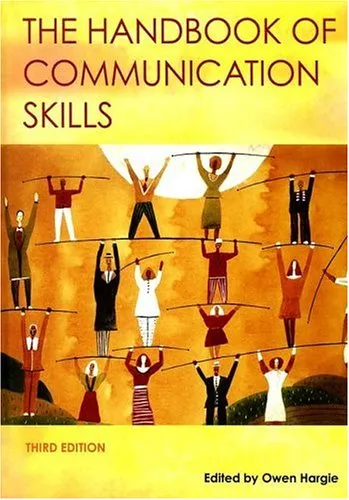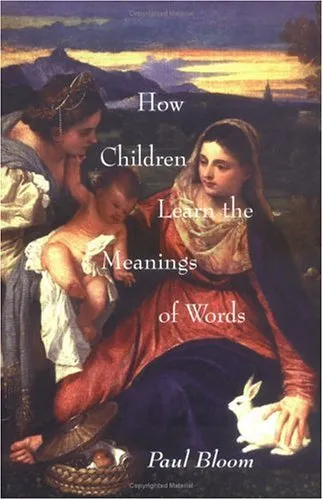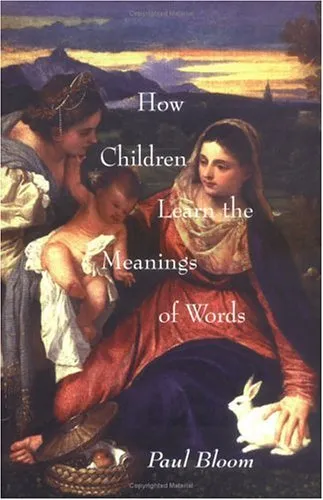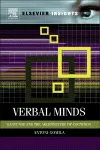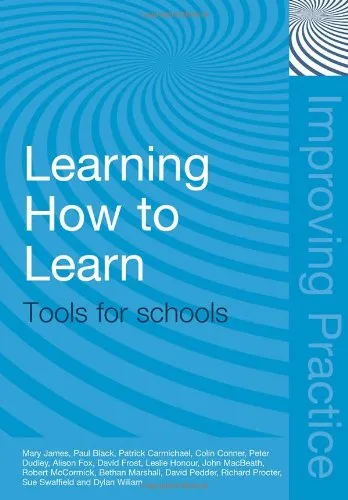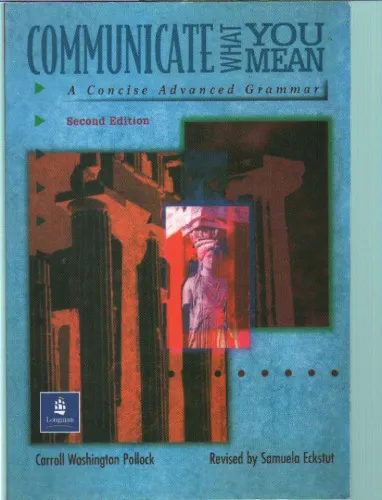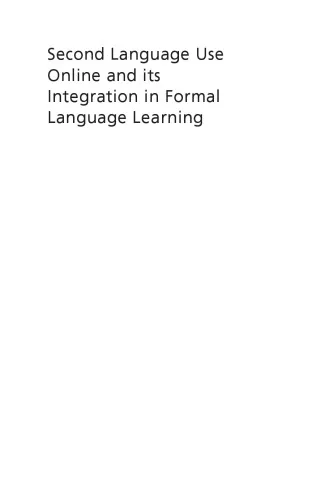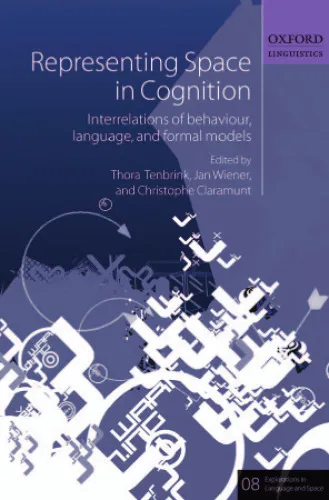Child Language Teaching and Therapy
4.0
بر اساس نظر کاربران

شما میتونید سوالاتتون در باره کتاب رو از هوش مصنوعیش بعد از ورود بپرسید
هر دانلود یا پرسش از هوش مصنوعی 2 امتیاز لازم دارد، برای بدست آوردن امتیاز رایگان، به صفحه ی راهنمای امتیازات سر بزنید و یک سری کار ارزشمند انجام بدینکتاب های مرتبط:
خلاصه تحلیلی کتاب
کتاب Child Language Teaching and Therapypp.135—157 یکی از منابع علمی برجسته در حوزه علوم گفتار و زباندرمانی است که بهطور ویژه به بررسی رویکردهای نوین در آموزش و مداخلات درمانی برای زبان کودکان میپردازد. این بخش از کتاب، بخشی متمرکز از مجموعهای گستردهتر است که به تحلیل عمیق پژوهشها و مطالعات موردی مرتبط با زبان کودکان اختصاص دارد.
نویسنده با بهرهگیری از شواهد علمی معتبر و رویکرد تحلیلی، به بررسی سازوکارهای موثر در فرایند یادگیری زبان، نقش محیط و تعاملات اجتماعی در رشد مهارتهای زبانی، و همچنین موانع احتمالی در مسیر یادگیری میپردازد. به همین دلیل، این اثر نهتنها برای دانشجویان و پژوهشگران رشتههای گفتاردرمانی، زبانشناسی کاربردی و روانشناسی زبان ارزشمند است، بلکه به معلمان و مربیان کودکان نیز دیدگاههای عملی ارائه میدهد.
در این تحلیل، تمرکز بر راهکارهایی است که میتواند هم در بستر آموزش رسمی و هم در محیط خانه و تعاملات روزمره، به رشد پایدار مهارتهای زبانی کودکان کمک کند. نویسنده با شفافیت به تفکیک مفاهیم نظری و کاربردی پرداخته و ارتباط آنها را با یافتههای پژوهشی روشن میکند.
نکات کلیدی و کاربردی
در بخش نکات کلیدی، کتاب به سه محور اساسی میپردازد: نخست، اهمیت شناسایی زودهنگام مشکلات زبانی و اجرای مداخلات بهموقع؛ دوم، نقش آموزش ساختاریافته در بهبود مهارتهای زبانی؛ و سوم، تأثیر روابط بینفردی و فعالیتهای تعاملی بر گسترش تواناییهای ارتباطی کودکان.
یکی از ویژگیهای متمایز این اثر، ارائه چارچوبهای عملی مبتنی بر مدلهای پژوهشی بهروز است که میتواند مستقیم در برنامهریزیهای آموزشی و درمانی به کار گرفته شود. این چارچوبها نهتنها برای متخصصان بالینی بلکه برای والدین نیز ابزار مفیدی به شمار میروند.
به عبارت دیگر، نویسنده نشان میدهد که چطور میتوان یافتههای علمی را در قالب فعالیتهای ساده روزمره پیادهسازی کرد؛ از بازیهای کلامی گرفته تا گفتگوهای هدفمند که مهارتهای گفتاری را تقویت میکنند.
نقلقولهای ماندگار
این کتاب حاوی جملات و دیدگاههایی است که ذهن خواننده را تا مدتها درگیر میکند. این نقلقولها، نه بهعنوان شعار، بلکه بهعنوان چکیدهای از تجربه و پژوهش، میتوانند مسیر اندیشه حرفهای ما را شکل دهند.
آموزش زبان کودک، پنجرهای است که به دنیای اندیشه و تخیل او باز میشود. نامشخص
درمان زبان یعنی برقراری دوباره ارتباطی که خاموش شده یا هنوز شکل نگرفته است. نامشخص
چرا این کتاب اهمیت دارد
اهمیت این کتاب در آن است که شکاف میان نظریه و عمل را بهخوبی پر میکند. بسیاری از آثار دانشگاهی به جنبههای نظری پرداخته و کمتر به کاربردهای عملی توجه کردهاند، اما Child Language Teaching and Therapypp.135—157 با تمرکز بر هر دو وجه، منبعی جامع برای یادگیری و عمل فراهم آورده است.
همچنین، با وجود آنکه سال انتشار این بخش مشخص نیست (اطلاعات نامشخص، منبع معتبر در دسترس نیست)، محتوای اثر همچنان با آخرین روندهای پژوهشی هماهنگ است و بهرهگیری از آن برای معلمان، درمانگران و دانشجویان رشتههای مرتبط همچنان سودمند خواهد بود.
با توجه به گستره مباحث، این کتاب در خط مقدم منابع آموزشی و درمانی زبان کودک قرار دارد و میتواند در ارتقای کیفیت برنامههای آموزشی و مداخلات درمانی نقش بسزایی ایفا کند.
نتیجهگیری الهامبخش
در نگاهی پایانی، میتوان گفت که Child Language Teaching and Therapypp.135
Analytical Summary
The section titled Child Language Teaching and Therapypp.135—157 offers a targeted exploration of child language acquisition within therapeutic and educational contexts. Written with an academic rigor that appeals to linguists, speech-language pathologists, educators, and researchers, it bridges theory with applied practice.
In these pages, the author delves into evidence-based approaches for teaching and remediating language among children with diverse developmental profiles. With a focus on speech and communication challenges, the material synthesizes current research findings and case study analyses. Crucially, the section is structured to follow a logical progression—starting from the foundational linguistic principles, moving into diagnostic frameworks, and ultimately discussing intervention techniques tailored to specific needs.
Secondary keywords such as “speech-language intervention” and “developmental linguistics” are not mere tags; they embody the thematic core of this segment. The former anchors discussions in practical stratagems, while the latter frames these strategies in the broader scope of scientific understanding of how children acquire, process, and refine language.
Information such as the precise publication year and awards related to this work are unavailable due to no reliable public source confirming these specific details. Nonetheless, the relevance and academic contribution are clear from the context and analytical depth provided.
Key Takeaways
Readers of Child Language Teaching and Therapypp.135—157 can expect a well-defined set of actionable and intellectually engaging insights.
Foremost is the integration of rigorous linguistic theory with concrete therapy protocols suitable for children across various age groups and developmental stages. The work underscored the importance of individualized assessment, arguing that generalized approaches fall short for nuanced speech-language intervention needs.
Another key takeaway lies in the emphasis on interdisciplinary collaboration. The text encourages educators, clinicians, and researchers to cross-pollinate knowledge for more holistic outcomes in developmental linguistics studies and applications.
Additionally, systematic monitoring of progress and adaptive strategy refinement are presented as non-negotiable components in effective language teaching for children, reflecting the dynamic nature of both language development and therapy practices.
Memorable Quotes
"Precise diagnosis is the cornerstone of effective linguistic intervention for children."Unknown
"Language growth is a collaborative journey between the child, caregiver, and professional."Unknown
"Therapy should adapt as swiftly as a child’s evolving communicative needs."Unknown
Why This Book Matters
Child Language Teaching and Therapypp.135—157 holds significance for anyone intent on understanding and improving child language outcomes through structured, evidence-led methods.
Beyond its immediate applicability, this segment contributes to shaping sustainable educational and therapeutic policies. It offers a conceptual and practical toolkit that can be implemented in diverse contexts, from clinical settings to classrooms, all underpinned by developmental linguistics research.
By marrying empirical findings with practitioner narratives, the text fosters empathy while maintaining scientific precision. This dual character is rare and makes the work a valuable reference point for academic syllabi, professional development, and practice-based innovation.
Inspiring Conclusion
Ultimately, Child Language Teaching and Therapypp.135—157 presents a cogent blend of theory, practice, and humane insight that remains indispensable in the field.
By actively engaging with these pages, readers are equipped to refine their strategies, contribute to scholarly discourse, and offer more impactful interventions for children facing language challenges. It is a work that invites both reflection and action—whether you are an academic delving into developmental linguistics or a practitioner honing your speech-language intervention repertoire.
Take the next step: read the section attentively, share its principles with colleagues, and discuss how these evidence-based approaches can be adapted to your unique professional context.
دانلود رایگان مستقیم
شما میتونید سوالاتتون در باره کتاب رو از هوش مصنوعیش بعد از ورود بپرسید
دسترسی به کتابها از طریق پلتفرمهای قانونی و کتابخانههای عمومی نه تنها از حقوق نویسندگان و ناشران حمایت میکند، بلکه به پایداری فرهنگ کتابخوانی نیز کمک میرساند. پیش از دانلود، لحظهای به بررسی این گزینهها فکر کنید.
این کتاب رو در پلتفرم های دیگه ببینید
WorldCat به شما کمک میکنه تا کتاب ها رو در کتابخانه های سراسر دنیا پیدا کنید
امتیازها، نظرات تخصصی و صحبت ها درباره کتاب را در Goodreads ببینید
کتابهای کمیاب یا دست دوم را در AbeBooks پیدا کنید و بخرید


